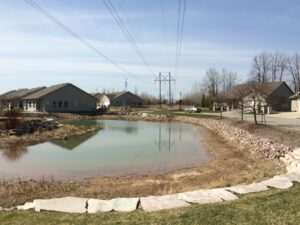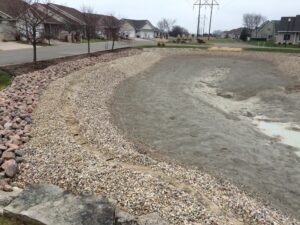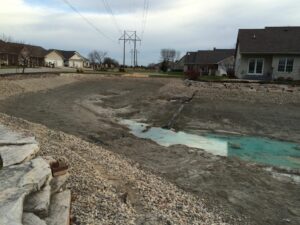LEAK!!
By Wisconsin Lake & Pond Resource Staff
If we ever get a call that a property owner’s pond is leaking, there is typically a root reason or event that is occurring other than an actual leak. Everyone fears the “L” word.

The most common concern is during the fill process. Quite commonly, a concern about a leak in the pond is brought to our attention because a “pond isn’t filling as fast anymore.” It seems like an obvious explanation, but some new pond owners do not realize that as the footprint of the pond increases as it fills, the filling process slows because of the increased water volume. This is the most common call we would get prior to educating a new pond owner beforehand.
Evaporation is the other cause for pond owners to bring up the “L” word. A pond without any swimmers or any other activity can lose upwards of 2 inches per week at the worst time of the year. Usually without supplementing, the level will continue to drop. In MOST locations, precipitation cancels out evaporation overall or may require very minor supplementing over the course of a season.

The majority of the time in any synthetically lined or clay lined pond, a leak is caused by physical damage post installation, given proper installation practices were followed. Most common is excavator damage post installation with synthetic liners, and burrowing rodents/animals with clay lined ponds.
If all potential obvious options for water loss or appearance of water loss are exhausted, the next step is to locate a leak. Pond levels will eventually drop to wherever the leak is. If there is an overflow structure, a thorough inspection would be beneficial before getting too involved. Debris can get into the structure during installation, preventing proper sealing of internal components.

When the water level stabilizes and doesn’t drop any more, the leak is more than likely around that perimeter of the pond. Look for any rodent digging in clay lined ponds, and any other items installed in the pond after the liner was installed. If the pond is larger than 1acre, electronic leak detection can be a less involved process to locate damage. Once located, clay can be repaired using Bentonite Clay, and a synthetic liner can be “patched” using the same material and welded in field with a hot air welder. Through proper installation practices, a leak in a lined pond can be avoided from the start. Inspection of subgrade prior to the liner installation, protective underlayment if needed, and inspection of all field welds are the crucial items that need to be looked at. Adequate protective stone material placed on top of the liner also allows for many years of enjoyment without the involvement of the “L” word!